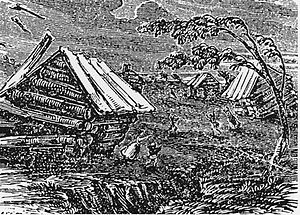1811–1812 New Madrid earthquakes

The New Madrid Earthquake, one of the largest earthquakes ever recorded in the contiguous United States, occurred on February 7, 1812. It got its name from its primary location in the New Madrid Seismic Zone, near New Madrid, Louisiana Territory (now Missouri).
This earthquake was preceded by three other major quakes: two on December 16, 1811, and one on January 23, 1812. These earthquakes destroyed approximately half the town of New Madrid. There were also numerous aftershocks in the area for the rest of that winter.
There are estimates that the earthquakes were felt strongly over 50,000 square miles (130,000 km2), and moderately across nearly one million square miles. The historic San Francisco earthquake of 1906, by comparison, was felt moderately over 6,000 square miles (16,000 km2).
Effects
Based on the effects of these earthquakes, it can be estimated that they had a magnitude of 8.0 on the Richter scale. As a result of the quakes, large areas sank into the earth, new lakes were formed (notably Reelfoot Lake, Tennessee), and the Mississippi River changed its course, creating numerous geographic exclaves, including Kentucky Bend, along the state boundaries defined by the river.
Some sections of the Mississippi River appeared to run backward for a short time. Sandblows were common throughout the area, and their effects can still be seen from the air in cultivated fields. Church bells were reported to ring in Boston, Massachusetts and sidewalks were reported to have been cracked and broken in Washington, D.C.[1]
Disaster relief
A request, dated January 13, 1814, by William Clark, the governor of Missouri Territory (the territory was renamed soon after the quake to eliminate confusion with the new state of Louisiana), asked for federal relief for the "inhabitants of New Madrid County". This was possibly the first example of a request for disaster relief from the US Federal government, which would later become the job of the Federal Emergency Management Agency.
Epicenter

The Reelfoot Rift goes back about 750 million years, to when the entire landmass of the earth constituted a single supercontinent, designated now as Rodinia. At the time a constructive fault zone began to form, now called the Reelfoot Rift, but it failed, and the zone became inactive.
About 550 million years later, at the time of the supercontinent called Pangaea, the fault zone again became active but no longer functioned as a constructive plate and remains in the same condition today. The earthquakes are therefore traced to seismic activity 5 to 25 kilometers (3-15 mi) below the crust of the earth.
Seismic Zone - 20th century
The epicenters of over 4,000 earthquakes can be identified from seismic measurements taken since 1974. It can be seen that the earthquakes originate from the seismic activity of the Reelfoot Rift. The zone which is strongly colored in red on the map is called the New Madrid Seismic Zone.
Topographic changes
Almost 200 years after the earthquakes in 1811 and 1812, the course of the Mississippi River as it was before the events is still visible in the landscape of the affected areas today. Along and parallel to the Tennessee/Arkansas state line, the shrunken riverbed is still present.
The old riverbed, however, still defines state lines along the river, resulting in numerous small jogs where the borders divert away from the river and incorporate small exclaves of land on the opposite side of the river from the rest of their state.
Such exclaves include the Kentucky Bend, a part of Kentucky whose only land boundary is with Tennessee, and the town of Reverie, Tennessee, which lies on the Arkansas side of the river.
Recent earthquakes

The zone remains active today. In recent decades minor earthquakes have continued.[1] New forecasts estimate a 7 to 10 percent chance, in the next 50 years, of a repeat of a major earthquake like those that occurred in 1811-1812, which likely had magnitudes of between 7.5 and 8.0. There is a 25 to 40 percent chance, in a 50-year time span, of a magnitude 6.0 or greater earthquake.[2]
On April 18th, 2008 a 5.2 earthquake struck near the southern borders of Illinois and Indiana. The epicenter was 19 miles SE of Olney, Illinois - close to the Ohio/Wabash rivers. A second earthquake followed less than 6 hours later just north of the region of the previous quake and registered a 4.6.
Understanding of this earthquake zone is growing slowly in comparison to awareness of the San Andreas fault.
Earthquake preparedness
The situation is more precarious than it was in 1811. The area is more densely populated, and many buildings have no earthquake resistant construction.
A few states have joined forces and founded a special institute for their earthquake zone, to prepare as well as possible for a major earthquake. The Mississippi River will probably present one of the incalculable problems. A few emergency funds for earthquake victims have been founded. Measures are also being ordered to mitigate any natural disaster resulting from an earthquake; thus in the construction of dams, bridges, and highways, earthquake safety is particularly being taken into account.
Gallery
-
Reelfoot Rift and NMSZ
-
View to the southwest along the former riverbed of the Mississippi River, south of the Tennessee/Arkansas state line near Reverie, Tennessee and Wilson, Arkansas (2007)
-
View to the northeast
-
Damage-range comparison between a moderate New Madrid zone earthquake (1895, magnitude 6.8), and a similar Los Angeles event (1994, magnitude 6.7).
See also
References
- United States Geological Survey (2003-10-15). "USGS Earthquake Hazards Program: 1811 - 1812 Earthquakes in the New Madrid Seismic Zone". Retrieved 2005-05-03.
- Jay Feldman. When the Mississippi Ran Backwards : Empire, Intrigue, Murder, and the New Madrid Earthquakes Free Press, 2005. ISBN: 0743242785




